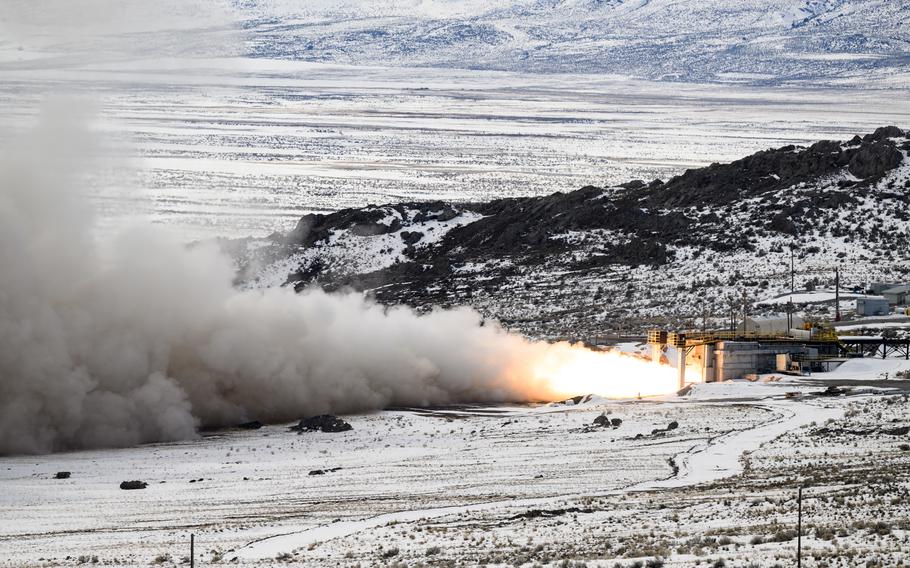
The Air Force Nuclear Weapons Center conducted its first full-scale static test fire of the LGM-35A Sentinel stage-one solid rocket motor at the Northrop Grumman test facility in Promontory, Utah, on March 2, 2023. The Air Force plans to replace the Minuteman III intercontinental ballistic missile with the next-generation Sentinel system currently in development. The Sentinel acquisition program represents the modernization of the land-based leg of the U.S. nuclear triad. (R. Nial Bradshaw/U.S. Air Force)
WASHINGTON — The Air Force for the first time has carried out a static fire test for the solid rocket motor that will power the service’s next-generation Sentinel ballistic missiles, officials said.
The test evaluated the rocket motor at a northern Utah site late last week, officials at the Air Force Nuclear Weapons Center and developer Northrop Grumman said. The solid rocket motor, or SRM, is the first of three stages that will power the future missiles and is the largest of the three.
Development of the Sentinel was first announced during former President Barack Obama’s administration as part of modernizing the U.S. nuclear triad — nuclear-capable missiles that can be launched from land, sea and the air.
“This test is just one part of our comprehensive ground and flight test program designed to help us shake down the design as we approach its critical design review,” said Maj. Gen. John Newberry, commander of Air Force Nuclear Weapons Center and program executive officer for strategic systems. “By testing early, we reduce risk to the overall weapon system schedule.”
The open-air test was performed March 2 at Northrop Grumman’s facility in Promontory, Utah. Company officials said the motor fired for the expected duration and met performance parameters and objectives within the expected ranges.
Promontory is about 75 miles northwest of Salt Lake City and is the same location where Morton Thiokol tested the solid rocket boosters that powered the Space Shuttle fleet from 1981 to 2011. The SRM test last week resembled the shuttle booster tests carried out in the 1980s.
The SRM test was the first of several that will be conducted to validate whether the motor is safe for use on Sentinel missiles, Northrop Grumman said. Analyses and qualification testing must also be done before the motor, as well as the other propulsion stages, can become operational.
“Our investments in digital design, test and advanced manufacturing help to ensure we develop this next-generation missile more affordably and with innovation at its core, delivering to the Air Force a safe, secure, reliable and flexible capability,” said Sarah Willoughby, Northrop Grumman’s vice president of the Sentinel program.
Northrop Grumman and Boeing won contracts to explore building the Sentinel missile system, but Northrop Grumman gained the right to manufacture the new system when Boeing opted not to bid.
The Sentinel will replace Minuteman III ICBMs that have been in the U.S. nuclear arsenal since 1970. The Air Force said about 400 Minuteman IIIs remain operational at various locations in Wyoming, Montana, Nebraska and North Dakota. Deactivated Minuteman III silos are also still intact in South Dakota and Missouri.
The Sentinel is expected to make its first flight sometime in late 2023, according to a report last month by Aviation Week. The Air Force expects the first Sentinel missiles to be active by the end of the 2020s and operational until at least the 2070s.
Several other companies will work on the Sentinel as subcontractors, including Lockheed Martin and General Dynamics.
The Trident II submarine-launched missile, which entered service in the 1990s, and the AGM-86 ALCM air-to-ground missile are also part of the U.S. nuclear triad. The Air Force is in the process of replacing the AGM-86 with the Long Range Stand Off Weapon, which is being developed by Raytheon Technologies and expected to enter service in the 2030s.